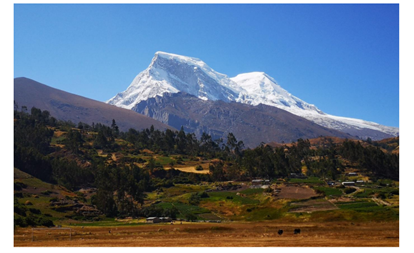Lead Supervisor: Stuart Black, Department of Geography and Environmental Science, University of Reading
Email: s.black@reading.ac.uk
Co-supervisors: Chris Vane, British Geological Survey; Alison MacLeod, Department of Geography and Environmental Science, University of Reading
Background: In South America, more than 80% of the population is reliant on water supplies from mountainous areas for drinking water and agriculture. The main source of this water discharge is stored in mountain glaciers, which are known to be retreating at an unprecedented rate due to climate change. Once the glacier at the summit of Mt Kilimanjaro in Africa has melted, all the world’s tropical glaciers will be located in the Andes (Kaser, 1999), mainly in Bolivia or Peru. Thus, mountain glaciers are important water sources in the dry, seasonal upland environments, but are also a very sensitive measure of present day and future climate change. These glaciers in turn feed upland Andean lakes and mires making these also equally sensitive repositories of climate change, and associated changes in the environment, including land-use.

Figure 1. Nevado Huascaran in the Ancash region of Peru, one of the few remaining mid-latitude glaciers
As a result, lakes and mires in the Peruvian Andes provide an opportunity to explore the history and reconstruction of climate change and the input from glacial water sources and their impacts on the environment, and to provide an important palaeo-analogue for future scenarios. Several archaeological, palaeoclimatic and palaeoenvironmental studies in the Andes have already highlighted the possible connection between past climate fluctuations, and significant cultural expansion and collapse, and associated changes in vegetation, mainly over the last 2000 years. However, the relationship remains unclear, and there is a need for much higher spatial and temporal resolution studies that go back further in time before these data are useful in future scenarios.
Highland Andean environments are thus the ideal natural laboratory to test the sensitivity of various climate and environmental proxies, and the nature and timing of human responses to climate change. In addition, the upland Andean systems have been an important agricultural base for human communities for 1000’s of years making them particularly important for the future where food security and demand for viable agricultural land are key. In addition, changing climate zones (Koppen-Geiger climate classifications) are numerous across Peru due to its unique geography. As a result, the project will also test the changing climate zones over time
Aim: This project aims to integrate geochemical biomarker, sediment DNA, isotope and palaeoecological data with quantitative modelling to determine the impact of past climate and environmental change in the Peruvian Andes.
Methodology: Recently, techniques for obtaining empirical climate and environmental reconstruction data have become increasingly more accessible and quicker to obtain. We are now able to collect time-integrated materials (lake cores, peat and mire deposits) that can be dated accurately and analysed for a range of environmental and climatic markers and fingerprints quickly. However, until now many of these proxies have largely been investigated in isolation or occasionally as a combination of components. This studentship will bring together data from organic geochemistry (lipid, and plant wax biomarkers), palaeoecology (non-pollen palynomorphs in the form of spores), inorganic geochemistry (heavy and light stable isotopes) and ancient DNA from upland Andean Lake and mire systems to explore the connections between the response to past climate changes. Chronologies of the sequences will be established with radiocarbon dating and tephra horizon identification. Four sites will be cored in upland lakes from Peru (Ayacucho, Cusco, Chillón valley and Huarca, N. Peru covering all the key climate classification zones) and analysed for multi-proxy signals detailed above and compared statistically to singular records from existing core material available on the NOAA palaeoclimate database (https://www.ncdc.noaa.gov/). The reconstructed climate and environmental markers will be used to create predictions for a geographical-based model (built in ArcGIS Model Builder) to combine all the data together to produce time-sliced geographical outputs of environmental and climate sensitivity which will be useful for coping with future climate change.
Wider scope and relevance: The project fits with multiple key SCENARIO science themes namely:
- Climate and climate change on global, regional and local scales.
- Biogeochemical cycles – changes to ecosystems and biodiversity loss.
- Applied ecology and biodiversity – changes of plant communities over time.
The concept of understanding long-term climate and environmental changes, and the nature of water availability and its management, to human societies are at the heart of the NERC science themes.
Training Opportunities
This project is supported by The British Geological Survey. The student will also undertake a placement at the British Geological Survey for up to 3 months in total (which is flexible) to undertake some of the laboratory methods. The student will also receive outstanding fieldwork opportunities at sites in S. America including visits to the major climatic zones of highland Peru and the opportunity to participate in real-world understand of the impacts of climate change.
Student Profile
The project will have wide appeal to a range of different disciplines. As the project will involve a multi-disciplinary approach, we have no set preference as to the background of the student and are willing to train the student in areas that they do not have experience in previously. However, a strong background in numerical/statistical or analytical techniques is essential. Knowledge of isotope ecology, biogeography and/or Quaternary science would be advantageous. A student trained in any of the following areas would be appropriate: Ecology, various aspects of Biological Science, Environmental Science, Meteorology, Geology, Environmental Chemistry and Geochemistry.
Funding Particulars
This project has support from the British Geological Survey.

